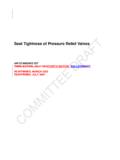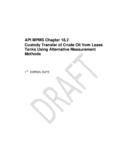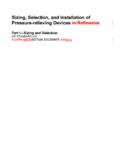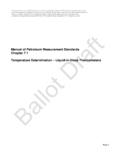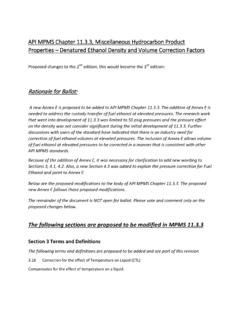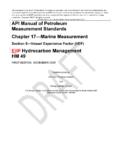Transcription of API RP520 Part II2, Sixth Fifth Edition, Ballot 2 …
1 3/7/2013 Ballot 2 Page 1 of 71 API RP520 part II2, Sixth Fifth edition , Ballot 2 sizing , Selection, and Installation of Pressure-Relieving Devices in Refineries part II2 Installation 3/7/2013 Ballot 2 Page 2 of 71 CONTENTS 1. SCOPE .. 6 2. REFERENCES .. 6 Normative References .. 6 Informative References .. Error! Bookmark not defined. 3. DEFINITION OF TERMS .. 6 4. PRESSURE RELIEF DEVICE LOCATION .. 6 Proximity To Protected Equipment .. 7 Pressure Fluctuations .. 7 Vibration .. 7 Operating Environment .. 8 Free Draining .. 8 Maintainability .. 8 5. INLET PIPING REQUIREMENTS .. 8 General .. 8 Minimum Diameter .. 8 Layout .. 8 Isolation Valves In Inlet Piping .. 8 Process Laterals Connected To Inlet Piping Of Pressure Relief Valves .. 8 PRV Inlet Line Length and Pressure Loss .. 9 Inlet Stresses That Originate From Static Loads In The Discharge Piping.
2 9 Thermal Stresses .. 9 Mechanical Stresses .. 9 Inlet Stresses That Originate From Discharge Reaction Forces .. 9 Determining Reaction Forces In An Open Discharge System .. 9 Determining Reaction Forces in a Closed Discharge System .. 11 6. DISCHARGE PIPING FROM PRESSURE RELIEF DEVICES .. 11 General Requirements .. 11 Safe Disposal Of Relieving Fluids .. 11 Back Pressure Limitations And sizing Of Pipe .. 11 General .. 11 Thermal Relief Valves .. 12 Considerations For Pilot-Operated Pressure Relief Valves .. 12 Stresses In Discharge Piping During Release .. 12 Isolation Valves In The Discharge Piping .. 12 Rupture Disks Installed At Outlet Of Pressure Relief Valve .. 12 7. PRV STABILITY .. 13 General .. 13 PRV Cycling .. 13 PRV Flutter .. 13 PRV Chatter .. 13 Potential Causes of PRV Instability .. 14 General .. 14 Excessive PRV Inlet Pressure Loss.
3 14 Excessive Built-up Backpressure .. 14 Acoustic Interaction .. 14 3/7/2013 Ballot 2 Page 3 of 71 Retrograde Condensation .. 15 Improper Valve Selection .. 15 PRV Inlet Pressure-Drop Limitations .. 15 General .. 15 Pressure Relief Valve Capacity .. 16 Adjustments to Set Pressures Based on Upstream System .. 16 PRV Inlet Loss Criteria .. 16 Background on PRV Inlet Pressure Loss Criteria .. 17 Engineering Analysis .. 17 Calculating Non-recoverable PRV Inlet Losses .. 18 Inlet Loss Criteria for Thermal Relief Valves .. 19 Inlet Loss Criteria for Remote Sensing for Pilot-Operated Pressure-Relief Valves 20 PRV Selection .. 20 8. ISOLATION (STOP) VALVES IN PRESSURE RELIEF PIPING .. 22 General .. 22 Application .. 22 Isolation Valve Requirements .. 23 General .. 23 Inlet and Outlet Isolation Valves .. 23 Installation of Spare Relief Capacity.
4 24 Three-Way Changeover Valves For Dual Pressure Relief Device Installations .. 25 Use of Ball Valves as Three-Way Changeover Valve .. 25 Examples Of Isolation Valve Installations .. 25 Administrative Controls Related To Isolation Valves .. 26 9. RUPTURE DISK INSTALLATIONS .. 26 Rupture Disk Devices In Combination With Pressure Relief Valves .. 26 Rupture Disks In Series .. 26 10. BONNET OR PILOT VENT PIPING .. 27 General .. 27 Conventional Valves .. 27 Balanced Bellows Valves .. 27 General .. 27 Bonnet Vent for Bellows Valve Handling Non-Hazardous Vapors .. 28 Bonnet Vent for Bellows Valve Handling Hazardous Vapors .. 28 Bonnet Vent for Bellows Valve Handling Non-Hazardous Liquids .. 28 Bonnet Vent for Bellows Valve Handling Hazardous Liquids .. 28 Balanced Piston Valves .. 28 Pilot-Operated Valves .. 28 11. DRAIN PIPING .. 29 Installation Conditions That Require Drain Piping.
5 29 Safe Practice For Installation Of Drain Piping .. 29 12. PRE-INSTALLATION HANDLING AND INSPECTION .. 29 General .. 29 Storage And Handling Of Pressure Relief Devices .. 29 3/7/2013 Ballot 2 Page 4 of 71 Inspection And Cleaning Of Systems Before Installation .. 30 13. PRESSURE-RELIEF DEVICE INSTALLATION AND MAINTENANCE .. 30 Mounting Position .. 30 Care In Installation .. 30 Pressure Relief Valves .. 30 Rupture Disk Devices .. 31 Pin-Actuated Devices .. 31 Proper Gasketing And Bolting For Service Requirements .. 31 Inspection And Maintenance .. 31 Test Or Lifting Levers .. 31 Heat Tracing And Insulation .. 32 Figure 1 Typical Pressure Relief Valve Installation: Atmospheric (Open) Discharge .. 34 Figure 2 Typical Pressure Relief Valve Installation: Closed System Discharge .. 35 Figure 3 - Typical Rupture Disk Device Installation: Atmospheric (Open) Discharge.
6 36 Figure 4 Typical Pressure Relief Valve Mounted on Process Line .. 38 Figure 5 Typical Pressure Relief Valve Mounted on Long Inlet 39 Figure 6 Typical Pilot-Operated Pressure Relief Valve Installation .. 40 Figure 7 Typical Pressure Relief Valve Installation with Vent Pipe .. 41 Figure 8 - Typical Rupture Disk Device In Combination With Relief Valve: Inlet Side Installation .. 42 Figure 9 Avoiding Process Laterals Connected to Pressure Relief Valve Inlet Piping .. 43 Figure 10 Typical Pressure Relief Device Installation with an Isolation Valve .. 44 Figure 11 Typical Pressure Relief Device Installation for 100 Percent Spare Relieving Capacity .. 45 Figure 12 Alternate Pressure Relief Device Arrangement for 100 Percent Spare Relieving Capacity .. 46 Figure 13 Alternate Pressure Relief Device Installation Arrangement for 100 Percent Spare Relieving Capacity .. 47 Figure 14 Three-Way Changeover Valve Shuttle Type.
7 48 Figure 15 Three-Way Changeover Valve Rotor Type .. 49 Figure 16 Three-Way Changeover Valve Ball Types .. 50 Figure 17 Typical Flare Header Block Valves .. 51 Figure 18 Typical Isolation Block Valves for Spare Compressor .. 52 Figure 23 Typical Installation Avoiding Unstable Flow Patterns at Pressure relief Valve Inlet .. 57 APPENDIX A RUPTURE DISK INSTALLATION GUIDELINES .. 58 Figure Typical Configuration of Companion Flanges, Gaskets and Rupture Disk Assembly .. 63 Figure Proper Handling of a Rupture Disk .. 64 Figure Improper Handling of a Rupture Disk .. 64 Figure Proper Alignment of Rupture Disk indicated by Tag Arrows .. 65 APPENDIX B INSTALLATION & MAINTENANCE OF PIN-ACTUATED NON-RECLOSING PRESSURE RELIEF DEVICES .. 66 APPENDIX C PRV Acoustic Interaction .. 68 PRV Acoustic Interaction .. 68 Applicability .. 68 3/7/2013 Ballot 2 Page 5 of 71 PRV Inlet Line Length Limits.
8 68 Maximum Acoustic Length Calculation .. 69 Speed of Sound .. 69 Speed of PRV Opening .. 70 Bibliography .. 71 3/7/2013 Ballot 2 Page 6 of 71 sizing , Selection, and Installation of Pressure-Relieving Devices in Refineries part II Installation 1. SCOPE This recommended practiceStandard covers methods of installation for pressure relief devices for equipment that has a maximum allowable working pressure (MAWP) of 15 psig ( bar g or 103 kPA) or greater. Pressure relief valves or rupture disks may be used independently or in combination with each other to provide the required protection against excessive pressure accumulation. As used in this recommended practiceStandard, the term pressure relief valve includes safety relief valves used in either compressible or incompressible fluid service, and relief valves used in incompressible fluid service. This recommended practiceStandard covers gas, vapor, steam, two-phase and incompressible fluid service; it does not cover special applications that require unusual installation considerations.
9 2. REFERENCES The current editions of the following standards, codes, and specifications are cited in this recommended Standardpractice: Informative References API STD 510 Pressure Vessel Inspection Code: In-Service Inspection, Rating, Repair and Alteration STD 526 Flanged Steel Pressure Relief Valves STD 521 RP STD 521 Guide for Pressure-Relieving and Depressuring Systems RP 576 Inspection of Pressure Relieving Devices ASME1 Power Piping Process Piping Boiler and Pressure Vessel Code, Section VIII, Pressure Vessels Normative References API STDRP 520 sizing , Selection, and Installation of Pressure Relieving Devices in Refineries, part I1 sizing and Selection 3. DEFINITION OF TERMS The terminology for pressure relief devices that is used in this recommended practiceStandard is in general agreement with the definitions given in API Recommended PracticeSTDRP 520 part I1.
10 4. PRESSURE RELIEF DEVICE LOCATION AND POSITION Turbulence In Pressure-Relief Device Inlets See for information regarding the effects of turbulence on pressure-relief valves. 1 ASME International, Three Park Avenue, New York, New York 10016-5990, Formatted: Heading 2, Indent: First line: 0" 3/7/2013 Ballot 2 Page 7 of 71 4. There are a number of design issues that should be considered when determining the location of the pressure relief device. Proximity tTo Pressure Source Protected Equipment The pressure relief device should normally be placed close to the protected equipment or system of equipment so that the pressure in the protected equipment inlet pressure losses to the device are stays within Code the allowable limits and to avoid PRV instability (see ). For example, where protection of a pressure vessel is involved, mounting the pressure relief device directly on a nozzle on top of the vessel may be necessary.
